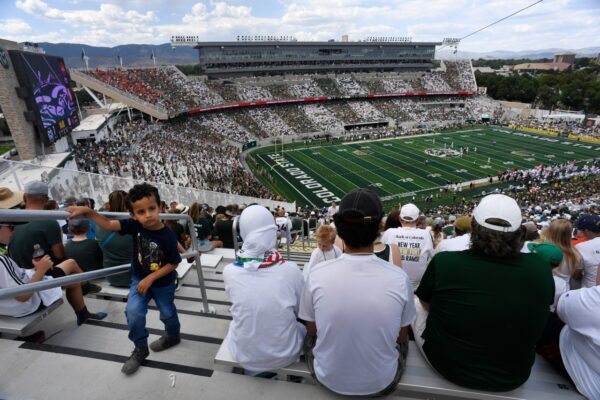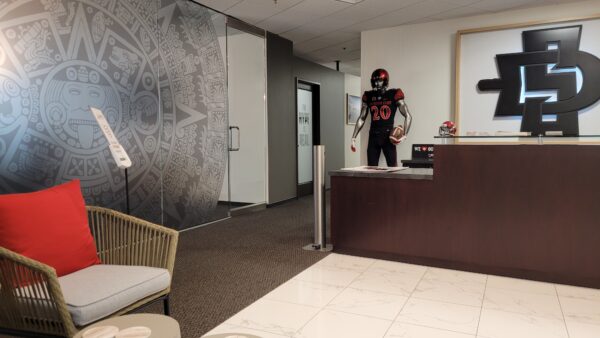What will new Aztec Stadium be like for Class of 2022?

Credit: Aztec Stadium

Fans entering Dignity Health Sports Park on Friday will be given a mini-replica of the new Aztec Stadium. It is another reminder of what still feels surreal to many, SDSU’s new on-campus home is nearing completion. Since San Diegans passed Measure G and created SDSU Mission Valley, fans and pundits have forecasted what Aztec Stadium will mean to the players. The difficult part with these projections is that with fewer than 20 stadiums built this millennium, there is not a lot of first-hand experience.
One person, however, who knows in great detail how SDSU players will feel when they first set foot inside Aztec Stadium is Ben Knox. Knox, an offensive lineman, graduated from Colorado State in 2018. Over his two-year career, he started 19 games, including 12, his senior season. He was a cornerstone for an offense that ranked first in the Mountain West and 11th in the country in total offense his final year in Fort Collins.
“Opening a new stadium will help with recruiting,” Knox told EVT this week. “With the hopes for top of the line equipment, locker rooms, and meeting rooms since we spend most of our time there. (It will) swipe the slate clean. You have to make a new history inside of the new building as well.”
Knox joined the Rams in 2017, the same year Colorado State opened Canvas Stadium. Among thousands of college football players, Knox’s experience stands out because he was part of a group that made history. There can only be one first recruiting class to grace a new stadium.
“It was very important,” Knox replied when asked what the experience meant to him. “It also was a lot of fun, personally. Etching my name into history. I enjoyed the new stadium, and Canvas will always have a special place in my heart. Specifically, the opener and first time ever beating a CSU opponent there.”
December 15 is the early signing day for college football. SDSU currently has 17 commitments for the class of 2021, leaving only a few spots available for this historic class. Whoever ends up signing a National Letter of Intent with the Aztecs will join Knox as one of the few college athletes to open up a new stadium.
“It’s just a really unique situation,” Matt Razzano, SDSU Football Recruiting Analyst, explained to EVT in September. “There’s not many schools that are building new stadiums around the country, and that’s something that we’re really utilizing as a recruiting tool because that’s going to be the home of the new student-athletes that come here. That’s such a big part of their experience that they’re going to get as student-athletes here.”
Ben Knox would agree.
The Experience

On the first floor of an office building, roughly 25 football fields west of the new stadium site, is the Aztec Stadium Experience Center. As the name suggests, it is the best way to experience SDSU Mission Valley before the stadium opens. On Tuesday, the East Village Times took a tour with an eye on purchasing season tickets in the new stadium. Ticket Sales Representative Zack Tenorio was the guide for the curated trip into the design of the project and the hopes the university has for campus expansion.
A common complaint levied against the new stadium is its lack of size compared to the edifice it is replacing. And while the new stadium is designed with 15,000 fewer seats than the original San Diego Stadium, the lack of seats should not be confused for a lack of ambition for the project.
Longtime residents of San Diego know the divide between North and South County. Though they share the same geographic moniker, there is a great cultural distance between the two areas, with the Interstate Eight freeway a no man’s land between them. Sports has been one of the most unifying elements in the community.
For decades, Jack Murphy Stadium was where all San Diegans would gather to cheer on the Padres, Chargers, and Aztecs regardless of zip code. When the Padres left the area, however, the unity the stadium provided vanished. At their best, even the Chargers and the Aztecs could not galvanize the fractured county split at Mission Valley. There simply were not enough football games each year to unite the region.
SDSU has set its sights on being the catalyst to bring the county back together. More than Aztec football, they aim for the stadium to be used up to 365 days of the year. Beyond the stadium, they envision a campus expansion that people from the area can come to shop, stay-cation, recreate, and enjoy in a location central to everyone in the county.
[wpedon id=”49075″ align=”center”]
Throughout the presentation, it was obvious the university learned from the experiences of the past. Given SDSU has been part of San Diego since 1897, this is hardly surprising. Whether it was the bust of Don Coryell or the statue of Jack Murphy and his dog, Abe, strategically placed inside the 3D tour of the new stadium, the history of San Diego Stadium was on full display.
About 6,000 season tickets have been sold, with 2,000 of those premium seats. In fact, only nine total seats remain in the West Club premium location. The university hopes to sell between 12,000 to 15,000 season tickets. They have nearly matched the final season ticket numbers from the last season at SDCCU stadium. In January, tickets will be made available to the public. As the stadium site looks less like a construction zone and more like the newest stadium in college, SDSU appears poised to reach its lofty aspirations.
Tenorio did an incredible job answering every question and explaining the vision for the project. He sold six tickets. In about ten months, come say hello—section 101.
My earliest sport’s memory involve tailgating at the Murph, running down the circular exit ramps, and seeing the Padres, Chargers and Aztecs play. As a second generation Aztec, I am passionate about all things SDSU. Other interests include raising my four children, being a great husband and teaching high school.